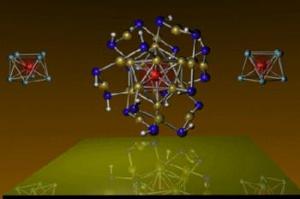|
Related Topics: |
|
|
|
Current News |
|
Chemistry A to Z |
|
About Internetchemistry |
Magnetic Superatoms |
|
The newly discovered cluster, consisting of one vanadium and eight cesium atoms, acts like a tiny magnet that can mimic a single manganese atom in magnetic strength while preferentially allowing electrons of specific spin orientation to flow through the surrounding shell of cesium atoms. The findings appeared online in the journal Nature Chemistry. |
|
Through an elaborate series of theoretical studies, Shiv N. Khanna, Ph.D., professor in the VCU Department of Physics, together with VCU postdoctoral associates J. Ulises Reveles, A.C. Reber, and graduate student P. Clayborne, and collaborators at the Naval Research Laboratory in D.C., and the Harish-Chandra Research Institute in Allahabad, India, examined the electronic and magnetic properties of clusters having one vanadium atom surrounded by multiple cesium atoms. They found that when the cluster had eight cesium atoms it acquired extra stability due to a filled electronic state. An atom is in a stable configuration when its outermost shell is full. Consequently, when an atom combines with other atoms, it tends to lose or gain valence electrons to acquire a stable configuration. According to Khanna, the new cluster had a magnetic moment of five Bohr magnetons, which is more than twice the value for an iron atom in a solid iron magnet. A magnetic moment is a measure of the internal magnetism of the cluster. A manganese atom also has a similar magnetic moment and a closed electronic shell of more tightly bound electrons, and Khanna said that the new cluster could be regarded as a mimic of a manganese atom. “An important objective of the discovery was to find what combination of atoms will lead to a species that is stable as we put multiple units together. The combination of magnetic and conducting attributes was also desirable. Cesium is a good conductor of electricity and hence the superatom combines the benefit of magnetic character along with ease of conduction through its outer skin,” Khanna said. “A combination such as the one we have created here can lead to significant developments in the area of “molecular electronics,” a field where researchers study electric currents through small molecules. These molecular devices are expected to help make non-volatile data storage, denser integrated devices, higher data processing and other benefits,” he said. Khanna and his team are conducting preliminary studies on molecules composed of two such superatoms and have made some promising observations that may have applications in spintronics. Spintronics is a process using electron spin to synthesize new devices for memory and data processing. The researchers have also proposed that by combining gold and manganese, one can make other superatoms that have magnetic moment, but will not conduct electricity. These superatoms may have potential biomedical applications such as sensing, imaging and drug delivery. This research was supported by the U.S. Department of the Army. |
|
|
|

